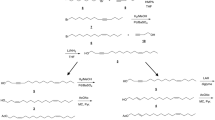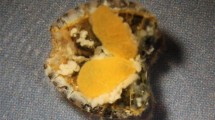Abstract
In field experiments, which started several years ago to investigate the means of chemical communication of the Maladera matrida beetle, we found that the ratio of males to females attracted to the bait (live females with food) was 3 : 2–5 : 4 60 : 40–55 : 45). These findings suggested that an aggregation pheromone is involved in the chemical communication, but the constant small preference for attracted males raised the question whether the active compound(s) is indeed an aggregation pheromone or whether it is a sex pheromone released by the female to attract the male. Since the traps used in our field studies were made of yellow plastic, we had to consider the possibility that the yellow color could have influenced the trapping of the flying beetles and biased the findings for the behavior and mode of attraction toward the source of the chemical communication. To clarify this point, we set out, in this study, to conduct field experiments in which we compared the standard yellow traps with black traps. We found that the bright yellow color did indeed affect the results for chemical communication: The total catch in the yellow traps was double that in black traps, and the male–female ratio in the black traps increased to 4 : 1(80 : 20). This result hints that a sex pheromone, and probably not an aggregation pheromone, as previously thought, is involved in the chemical communication of the M. maladera beetle.
Similar content being viewed by others
REFERENCES
Argaman, Q. 1986. Maladera matrida, a new Scarabaeidea in Israel. Shapirit 4:41–46 (in Hebrew), 67–68 (English summary).
Argaman, Q. 1990. Redescription of Maladera matrida (Coleoptera, Scarabaeidae, Melolonthinae). Isr. J. Entomol. 24:21–27.
Blight, M. M., and Smart, L. E., 1999. Influence of visual cues and isothiocyanate lures on capture of the pollen beetle, Meligethes aeneus in field traps. J. Chem. Ecol. 25:1501–1519.
Harari, A., Ben-Yakir, D., and Rosen, D. 1994. Mechanism of aggregation behavior in Maladera matrida Argaman (Coleoptera: Scarabaeidae). J. Chem. Ecol. 20:361–371.
Hendricks, D. E., Hollingsworth, J. P., and Hartstack, A. W., Jr. 1972. Catch of tobacco budworm moth influenced by color of sex-lure traps. Environ. Entomol. 1:48–51.
Ladd, T. L., and Klein, M. G. 1986. Japanese beetle (Coleoptera: Scarabaeidae) response to color traps baited with phenethyl propionate + eugenol + geraniol (3: 7: 3) and japonilure. J. Econ. Entomol. 79:84–86.
Landolt, P. J., and Phillips, J. W. 1997. Host plant influences on sex pheromone behavior of phytophagous insects. Annu. Rev. Entomol. 42:371–391.
Leal, W. S. 1998. Chemical ecology of phytophagous scarab beetles. Annu. Rev. Entomol. 43:39–61.
Mitchell, E. R., Agee, H. R., and Heath, R. R. 1989. Influence of pheromone trap color and design on capture of male velvet bean caterpillar and fall army worm moths ( Lepidoptera: Noctuidae). J. Chem. Ecol. 15:1775–1784.
Muirhead-Thomson, R. C. 1991. Trap Responses of Flying Insects. Academic Press, New York.
Sokal, R. R., and Rohlf, F. J. 1981. Biometry. W. H. Freeman, San Francisco.
William, R. N., Mcgovern, T. P., Klein, M. G., and Fickle, D. S. 1990. Rose chafer (Coleoptera: Scarabaeidae): Improved attractants for adults. J. Econ. Entomol. 83:111–116.
Yarden, G., and Shani, A. 1994. Evidence for volatile chemical attractants in the beetle Maladera matrida Argaman (Coleoptera: Scarabaeidae). J. Chem. Ecol. 20:2673–2685.
Yarden, G., Shani, A., and Leal, W. S. 1996. (Z,E )-α-Farnesene—an electroantennogram-active component of Maladera matrida volatiles. Bioorg. Med. Chem. 4:283–287.
Author information
Authors and Affiliations
Rights and permissions
About this article
Cite this article
Falach, L., Shani, A. Trapping Efficiency and Sex Ratio of Maladera matrida Beetles in Yellow and Black Traps. J Chem Ecol 26, 2619–2624 (2000). https://doi.org/10.1023/A:1005597031681
Issue Date:
DOI: https://doi.org/10.1023/A:1005597031681




